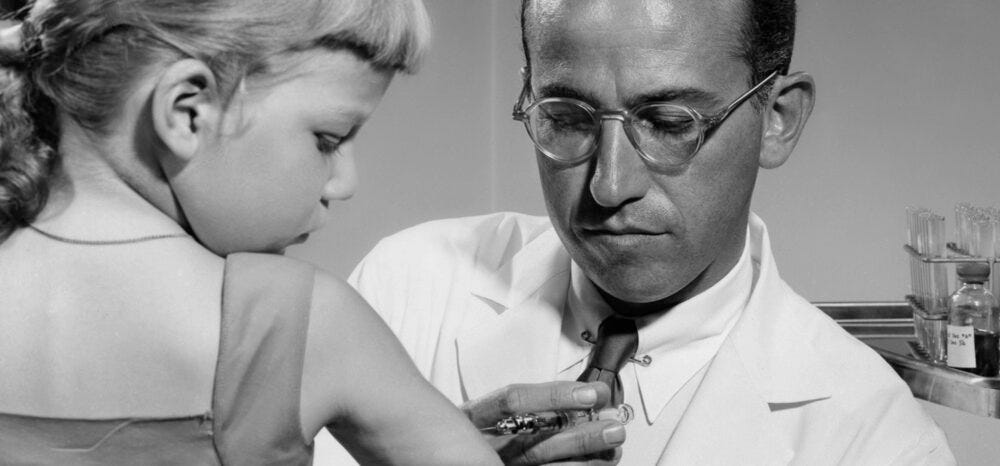

Sixty-six years ago, as fear gripped America, 1.8 million school children were injected with an unproven drug. The gamble? Eradicate the deadliest disease of the 20th century: Polio.
Not since the bubonic plague had an epidemic decimated, mystified and terrified humankind.
From 1347 to 1351, the Black Death killed 200 million people, between 30–60 percent of the planet’s population. It would take 200 years for the world to recover.
At the turn of the 20th Century, poliomyelitis was infecting mankind. Poliomyelitis, or polio, entered the body as a virus, assaulting nerve cells in the bloodstream, causing headaches, fever and vomiting. Within days, those stricken were paralyzed or dead. In 1789, English physician Michael Underwood identified polio as a distinct illness. In 1908, Austrian physicians Karl Landsteiner and Erwin Popper pinpointed the virus.
But it’s one thing to understand polio and quite another to treat it.
In 1919, polio killed 850,000 Americans and more than 20 million people worldwide. Millions more were disabled. Polio was now one of the world’s most feared diseases.
Incredibly, 36 years would pass before a cure was discovered.
What else must we do to ensure our organization is changing as fast as the world around us?
As polio attacked the world, Franklin Roosevelt became its most famous victim.
He’d contracted the virus on August 11, 1921 and was luckier than most. He didn’t die. He was paralyzed from the chest down.
Five years later, Roosevelt purchased a “four-story firetrap” in Warm Springs, Georgia, establishing a resort and clinic for polio victims. Two years later, FDR became New York’s governor, and by November 1932 he’d become America’s president. Roosevelt never allowed himself to be photographed in a wheelchair yet he used his position “to make America ‘polio conscious,’” calling his efforts a “crusade.”
With the slogan “Dance so that others might walk,” fundraising galas were held nationwide on 30 January 1934, FDR’s birthday, raising more than $1 million for polio research.
FDR founded a foundation in 1937 and Broadway star Eddie Cantor became an early volunteer, coining the name March of Dimes, which later became the foundation’s name. When Cantor urged Americans to send their dimes to FDR for his birthday, thousands of letters containing dimes flooded the White House. To commemorate FDR’s leadership, the Roosevelt dime was created after his death in 1945 and issued in 1946 on what would have been his 64th birthday.
The same year FDR held his first fundraising gala, the man who eventually would use those funds to cure polio completed his undergraduate studies.
Jonas Salk planned to study law in college but was overruled by his mother. Salk turned to chemistry. He loved the class, but his grades didn’t reflect his passion. Salk faced long odds applying to medical school: he was a lower middle-class Jew with even lower grades. But Salk stood apart from other applicants because he didn’t plan to practice medicine. “I saw myself trying to bring science into medicine.”
During his medical school interviews, Salk was warned he wouldn’t get rich from research. “There is more to life,” he replied, “than money.”
What’s the role of money in your life? How is that role serving you? How is it serving others?
If necessity is the mother of invention, curiosity is the father.
Salk’s curiosity propelled him forward, and upon his medical school graduation he’d proved that a killed-virus vaccine could provide immunity. On March 1, 1940, Salk became one of twelve interns at Mount Sanai Hospital, likened to “playing ball for the New York Yankees.” Two years later, Salk was appointed a research fellow in the University of Michigan’s Department of Epidemiology. He received a $2,100 fellowship the same day, a fortunate coincidence since the university position paid nothing.
With mentoring from Thomas Francis, Jr., Salk embarked on research to develop the first influenza vaccine. In autumn 1945, the U.S. Army vaccinated eight million soldiers, pre-empting a flu outbreak. As Salk gained notoriety, the relationship between master and apprentice grew strained.
Salk’s break came on May 27, 1947 when Max Lauffer invited him to consider leading the University of Pittsburgh’s animal virology laboratory. It was a gamble for Lauffer because Salk’s reputation was growing and the school was undistinguished and underfunded. To Salk, it offered “the prospect of independence” and he accepted.
The independence Salk perceived was misleading. Despite plenty of red tape and restraints, Salk persevered, expanding his lab staff in anticipation of March of Dimes funding. More important, Salk inspired his team with the belief each would play a significant role conquering polio.
By 1951, 28,000 new cases of polio were recorded. The forecast for 1952 was higher, so Salk decided to inject the vaccine they’d been developing into human patients. On 2 July 1952, 43 children received the vaccine. Results proved favorable.
On April 26, 1954, more than 1.8 million school children served as human guinea pigs—unimaginable today, but indicating the fear gripping America. The inoculation became the largest trial in history, financed and operated by volunteers using pencils and paper to track results.
The vaccine was pronounced safe on 12 April 1955. Salk was 40.
What’s the next great thing you and your colleagues will accomplish together?
Though Salk never sought a patent—“How could you patent the sun?” he asked—his vaccine eradicated one of history’s deadliest diseases and is one of the World Health Organization’s “Essential Medicines.”
- Greg Bustin, author of How Leaders Decide
